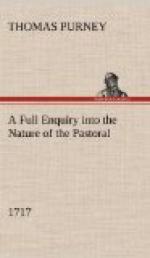One of Purney’s major purposes in the essay was to dignify the pastoral by demonstrating that it admits all the components generally reserved for tragedy and the epic. Most critics had considered the pastoral a minor form and consequently had narrowed their attention to a few frequently debated questions, mainly the state of rural life to be depicted and the level of the style to be adopted. All agreed that the poem should be brief and simple in its fable, characters, and style. But it was therefore a poetic exercise, no more significant, Purney complained, than a madrigal. He was intent upon investing the pastoral with all the major poetic elements—extended, worthy fable; moral; fully-drawn characters; and appropriate expression. For in his mind the poem best incorporates one of the only two true styles, the tender, and therefore warrants a literary status beneath only tragedy and the epic.
Like his critical method, Purney’s decision that the pastoral should depict contemporary rural life divested of what is vulgar and painful in it, rather than either the life of the Golden Age or true rustic existence places him on the side of Addison, Tickell, Ambrose Philips, and Fontenelle (indeed, his statement is a paraphrase of Fontenelle’s), and in opposition to the school of Rapin, Pope, and Gay, who argued for a portrait of the Golden Age. Both schools campaigned for a simplicity removed from realistic rusticity (which they detected in Spenser and Theocritus) and refinement (as in Virgil’s eclogues); but to one group the term meant the innocence of those remote from academic learning and social sophistication, and to the other the refined simplicity




